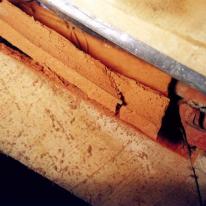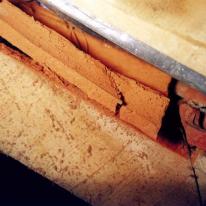Concrete or clay tiles broken or cracked
Listed under: concrete and cement, concrete tiles, Roof, wind, fixings and hardware, fixings, roof cladding, concrete or clay tiles
Cause
Wind or frost damage
Repair
-
replace broken or cracked tiles. The options are to use a matching new tile (where available) or a sound matching second-hand tile. New clay and concrete roof tiles are typically about 400 mm long and 250 mm wide, with lugs along the top edge to lock over the tile batten and hold the tile in place. If it is not possible to find an exact match for the particular roof tile, consider reusing sound salvaged materials removed from a less visible plane of the roof, replacing the salvaged tiles with a close matching new tile on that roof plane. Where the visual appearance is unacceptable, coating the tiles may be possible\
-
check that the timber battens in the roof are in good condition. Where necessary, replacement battens should be treated to at least H1.2 and free of visual defects. Replacement may require lifting the tiles adjacent to the damaged area to allow the old timber to be removed and the new timber inserted. For very high and extra high wind zones, screw battens to rafters or trusses
-
broken or cracked tiles can be removed by carefully lifting overlapping adjoining tiles. Use temporary timber wedges to hold the adjoining tiles up until the tile fixings for the damaged tile are cut. Insert the replacement tile. Fix in place with a nail or wire tie where possible – if not, ensure the new tile is locked into position when the timber wedges are removed and adjoining tiles lowered back down
-
roof tiles are usually held in place by the interlocking design of tile and nail fixings to the tile batten. Wire ties are commonly found in older tile roofs. Use hot dip galvanized steel fixings, or stainless steel fixings in coastal areas. Nails should be 2.8 mm minimum diameter and must penetrate 35 mm minimum into the batten
-
check the condition of flashings at the same time. Lead flashings that are still in reasonable condition should be left in place where possible, but consider replacing corroded metal flashings with inert material such as butyl rubber
-
take care avoid making problems worse by damaging more tiles. Where possible, use planks or a roof ladder to avoid too much weight on individual tiles
-
work at height is dangerous requires particular care. Always let someone know when you are working on a roof. You can find more details on the BRANZ Level website, and in the WorkSafe document Working on roofs – Good practice guidelines
Cause
Careless walking on the roof
Repair
- As above
Cause
The tiles are at the end of their serviceable life
Repair
-
eventually it becomes a better option to replace the whole roofing rather than constantly make repairs. If you are uncertain whether this point has been reached, consult an experienced registered building surveyor
-
there is the option of replacing with similar tiles, with masonry tiles of a different profile or colour, or reroofing with a different cladding material altogether
-
replacing the whole roof tile cladding with a similar tile will not need a building consent as long as the existing roof has met the relevant New Zealand Building Code performance requirement of at least 15 years. Where the roof cladding has failed within 15 years of installation or a different roofing is proposed, a building consent is likely to be required.
-
where reroofing is done by a contractor, the work must be carried out or supervised by a licensed building practitioner with a roofing licence
-
reroofing can also be carried out by the homeowner, but the local authority must be informed and the fact that the work was done by the homeowner will be recorded in the property file






